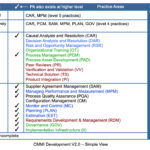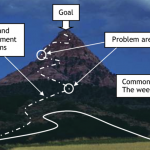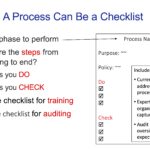Why Estimate? Deadlines drive most decisions in business, either because they drive revenue or they are one domino in a chain of events that drives revenue. Given that deadlines are important, adequate attention needs paying to estimation quality. Fundamental steps can be followed to make estimates reliable, whether teams use techniques such as guessing, Planning …continue reading >
I Just Want to Deliver My System On Time – I Don’t Know Why We are Always Late and I Can’t Pinpoint the Cause
I’m Drowning If you are a manager of an organization developing products or IT solutions, you might feel like you are drowning in a sea of missed deadlines and emergency meetings. How Did You Get to This Point? Here is an example of how managers often arrive at this situation. David is a senior manager …continue reading >
Improve Your Capability at Delivering Software and Systems – CMMI Quick Look
What is CMMI? CMMI is a collection of best practices used by software, hardware, IT development, and service organizations to improve their cost, schedule and quality results. It is organized into a roadmap that can be implemented incrementally over time. Useful links Summary of CMMI Formal and informal CMMI appraisals Changes in CMMI V3 Custom …continue reading >
When Scrum Uncovers Stinky Issue and Then Gets Blamed
Introduction Scrum is a simple and useful approach for managing software development projects. When performed correctly, it breaks work into manageable pieces and assesses technical risk. Some teams, however, run into trouble very quickly because Scrum is blamed when it uncovers stinky issues. In many cases Scrum is highlighting an existing problem, not causing it. …continue reading >
Kick-starting a Service Delivery Team – Pragmatically Using CMMI for Services
You are probably more than aware of the problems facing your service delivery organization. The list of problems usually starts with an overwhelming string of commitments and optimistic deadlines. Your staff members are working progressively longer hours, and new customers are anxiously waiting for your team to start working with them. Meanwhile, the supplier you …continue reading >
Synchronizing Scrum and Waterfall
Many organizations manage large projects using the Waterfall life cycle (See Figure 1). The life cycle (when used correctly) helps manage scope, time, cost and risk. It also provides visible milestones to coordinate team members and managers involved in the project. Like all life cycles, Waterfall has potential downsides, such as finding technical challenges late …continue reading >
Using Medical Checklists to Simplify CMMI Process Development – Keeping it Very Simple
Processes that describe how work is done can easily become long and cumbersome, making them difficult to read and use. To keep processes simple to write, review and update, consider using a checklist. In a previous article (Tidbit #8), I described two kinds of checklists: “Read-Do” checklists that state what steps to perform given specific …continue reading >
Using Scrum Wisely – Where does Design Fit?
The Scrum development method is a useful set of guidelines to help teams scope, plan, status and demonstrate their work. When done well, it allows teams to get early feedback on the product they are building and provides a reasonably disciplined method of managing changes in scope. Scrum includes some guidance for planning, estimation, requirements …continue reading >
Reducing Project Friction – Making Work Routinely Faster
The majority of organizations and teams around the globe want to work faster. However, not all groups have a systematic way to improve their speed, or maintain the speed they have. This tidbit summarizes steps that you can take to assess where your organization has friction and lists practices to improve and maintain your gains. …continue reading >
Using Checklists to Define Best Practices and Improve Performance
One of the underlying motives to document best practices within an organization is to reduce the mistakes made by project team members and managers. The resulting document can be used to train and remind people on expected practices. When an organization commits to define best practices, it has to decide how much detail to include …continue reading >
- « Previous Page
- 1
- …
- 6
- 7
- 8
- 9
- Next Page »





 The Process Group helps you improve your organization's capability to routinely meet deadlines and delivery quality expectations. We are certified CMMI appraisers / trainers and Certified Scrum Masters.
The Process Group helps you improve your organization's capability to routinely meet deadlines and delivery quality expectations. We are certified CMMI appraisers / trainers and Certified Scrum Masters. 